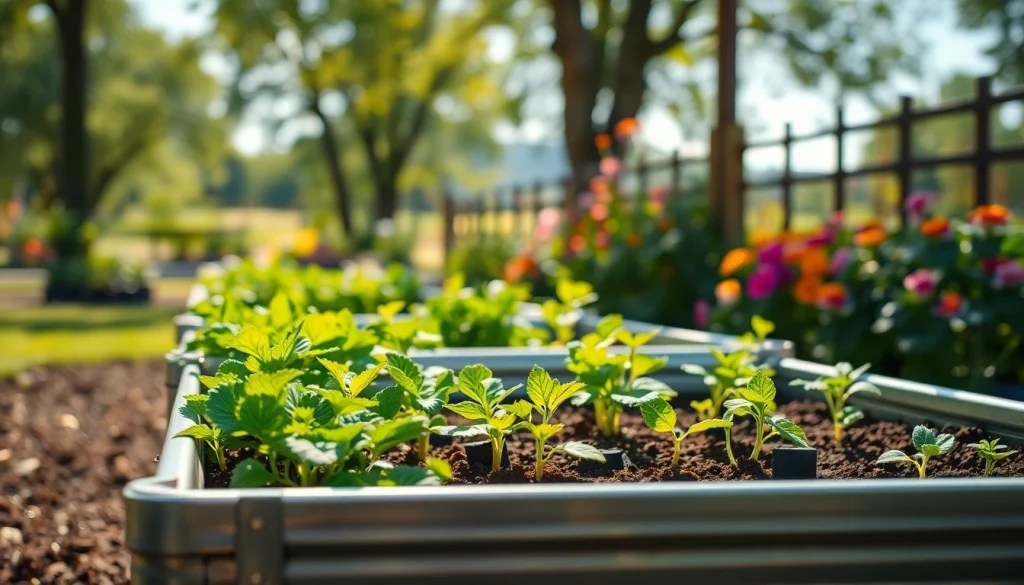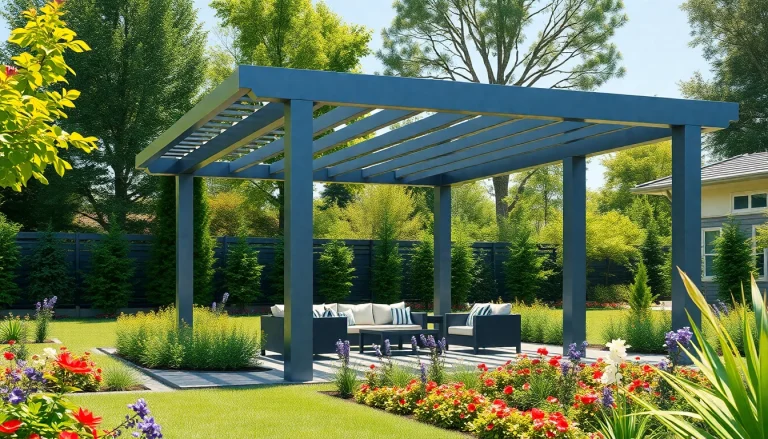
Understanding Landguard Raised Beds
What are Landguard Raised Beds?
Landguard raised beds are garden containers elevated above the ground, designed to create a conducive environment for growing plants. These beds typically feature structured sides, which can be made of various materials, allowing gardeners to cultivate soil that is free from grass and weeds. The elevation provides numerous advantages, including better soil drainage, improved aeration, and easier access for planting and maintenance. Moreover, the design enables a controlled growing environment, which can be particularly beneficial for urban gardeners or those with limited gardening space.
Benefits of Using Landguard Raised Beds
The advantages of incorporating landguard raised beds into your gardening strategy are ample. First, they facilitate excellent drainage, preventing waterlogging and root rot. This is crucial for the health of many plants, especially in regions where heavy rains are common.
Secondly, raised beds maximize soil warmth, allowing for an extended growing season. The soil in raised beds tends to heat up faster than in-ground gardens, which can lead to earlier planting opportunities in spring. Additionally, the controlled soil composition benefits plant health by ensuring that the necessary nutrients are retained effectively.
Raised beds also help reduce soil compaction since gardeners do not walk on the beds themselves. This leads to improved root growth and nutrient absorption. Furthermore, landguard raised beds can be positioned for optimal sunlight exposure, paving the way for a flourishing garden.
Materials and Design Options for Landguard Raised Beds
The materials used for raised beds play a crucial role in their longevity, aesthetic appeal, and practicality. Common options include:
- Wood: Often chosen for its natural appearance, wooden raised beds can be made from cedar, redwood, or treated lumber. They provide good insulation but may need to be treated to resist decay.
- Metal: Materials like galvanized steel or aluminum are known for their durability and modern look. They are resistant to pests and rot, lending to a longer lifespan than wood.
- Plastic: Recycled plastic beds are lightweight and resistant to weather-related wear and tear. They maintain warmth efficiently but may not have the same aesthetic as wood or metal.
- Brick or Stone: These materials offer a more permanent option that integrates nicely into landscaping. However, they can be labor-intensive to construct.
Choosing the right material depends on climate, budget, and design preferences. Regardless of the choice, ensure that the size and height of the raised bed accommodate the types of plants intended for cultivation.
Choosing the Right Location for Your Landguard Raised Beds
Sunlight and Water Drainage Considerations
When selecting a location for landguard raised beds, the first aspect to evaluate is sunlight. Most vegetables and flowering plants require at least 6 to 8 hours of direct sunlight each day to perform optimally. Observe your garden area throughout the day to identify the sunniest spots.
Furthermore, water drainage is pivotal. Raised beds should be placed in areas where water can drain away from the plants. Ideally, the location should be slightly elevated or you can consider landscaping techniques to ensure that stormwater drains away from the beds.
Accessibility and Aesthetic Appeal
Accessibility also plays a crucial role in the site selection. Place landguard raised beds within comfortable reach, allowing easy access to plant, weed, and harvest without excessive bending or stretching. Consider a width between 3 and 4 feet to facilitate easy access from both sides.
Lastly, do not underestimate the aesthetic impact of your raised beds. They should complement your overall garden design and landscape. Choose colors and materials that harmonize with other garden features to create an attractive overall appearance.
Common Mistakes When Placing Landguard Raised Beds
One common misstep is ignoring the potential for shading by nearby trees or buildings. Ensure your raised beds are positioned to receive adequate sunlight throughout the growing season. Another error is placing beds where drainage is poor, leading to water accumulation. Conduct a quick test by flooding the chosen area and observing how quickly the water drains away.
Finally, overestimating the height of the beds can lead to back strain during planting and maintenance. Aim for a manageable height that facilitates ease of use.
Soil Preparation and Plant Selection for Landguard Raised Beds
Ideal Soil Composition for Raised Beds
The success of any garden relies heavily on soil quality. For landguard raised beds, aim for a balanced mix that combines various components to enhance texture, drainage, and nutrient density. A common formula is:
- 40% Topsoil: Provides a base for nutrients.
- 30% Compost: Enriches the soil with organic matter and beneficial microbes.
- 30% Aerator Components: Such as perlite, vermiculite, or coconut coir, which improve aeration and water retention.
Before planting, it’s advisable to conduct a soil test to check pH levels and nutrient content. This will inform you of any amendments necessary to create a thriving environment for your plants.
Which Plants Thrive Best in Landguard Raised Beds?
Raised beds can support a variety of crops, but some vegetables thrive particularly well due to their growth habits and space requirements. Ideal candidates include:
- Root vegetables like carrots and radishes, which require loose, well-draining soil.
- Leafy greens such as lettuce and spinach, which appreciate the higher moisture and controlled soil conditions.
- Herbs including basil and parsley, which can benefit from the soil warmth and drainage.
- Fruiting plants like tomatoes and peppers, which thrive when given adequate space and nutrients.
Consider the growing season of the plants, and plan your garden layout to maximize space efficiently. Utilize vertical gardening techniques where necessary to expand your yield.
Crop Rotation and Soil Health Practices
Practicing crop rotation within your landguard raised beds is a vital practice for maintaining soil health and preventing pest buildup. By alternating plant families each growing year, you disrupt pest and disease cycles while replenishing soil nutrients.
Incorporating cover crops during the off-season can also enrich soil fertility, improve structure, and prevent erosion. Examples include clover and rye, which fix nitrogen and protect against weed growth.
Maintenance Tips for Healthy Landguard Raised Beds
Watering and Fertilization Guidelines
Proper watering is crucial for maintaining moisture levels in landguard raised beds. Implement a deep watering strategy, allowing water to penetrate the soil to encourage deeper root growth. A typical guideline is to water at least 1 inch per week, but this can vary based on the plant type and weather conditions.
Fertilization should occur based on soil testing results. Organic options like compost, well-rotted manure, or commercial organic fertilizers can be incorporated into the soil. Follow the labeled instructions for best practices on quantities and schedules.
Managing Pests and Diseases in Raised Beds
Preventive measures are key in managing pests and diseases in landguard raised beds. Utilizing companion planting can help deter harmful insects and enhance crop establishment. Regular monitoring for signs of pest damage or disease will alert you to potential issues before they escalate.
Introduce beneficial insects or employ physical barriers like row covers to shield young plants from pests. In case of an outbreak, be prepared to apply organic pesticides or disease control strategies specific to the affected plants.
Seasonal Care Routines for Landguard Raised Beds
Each season brings unique requirements for raised bed maintenance. In preparation for spring, clear away debris, test soil, and amend as necessary. During the growing season, keep an eye on moisture levels and growth progression.
As autumn approaches, harvesting diseased and spent plants will reduce pest populations. Additionally, consider planting cover crops to prepare the soil for the next growing cycle. Winter maintenance might include adding mulch or protective coverings to insulate the soil.
Maximizing Your Yield with Landguard Raised Beds
Techniques for Efficient Space Utilization
To maximize the yield from your landguard raised beds, utilizing advanced gardening techniques such as Square Foot Gardening can optimize plant spacing. This method involves dividing the gardening area into square-foot sections, each dedicated to different crops based on their size.
Additionally, implementing vertical gardening strategies, like trellising cucumber and tomato plants, can save ground space and increase production density without sacrificing yields.
Companion Planting Strategies for Landguard Raised Beds
Another effective way to enhance your raised bed garden is through companion planting. This method involves growing different plants in proximity for mutual benefits, such as improved pest control or pollination. Some advantageous pairs include:
- Tomatoes and Basil: Basil enhances the flavor of tomatoes and repels tomato hornworms.
- Carrots and Onions: Onions deter pests that would target carrots.
- Beans and Corn: Beans fix nitrogen in the soil while corn provides support for climbing beans.
Harvesting Tips to Ensure Bounty from Your Beds
Harvesting at peak ripeness not only enhances flavor but also encourages further production. Regularly check your plants for readiness, and remove overripe or diseased fruit promptly to promote continued growth. Utilize sharp, clean tools for harvesting to prevent plant damage.
Lastly, keep records of plant varieties, harvest dates, and performance to inform subsequent growing seasons, allowing you to refine your gardening practices for better yields in the future.






